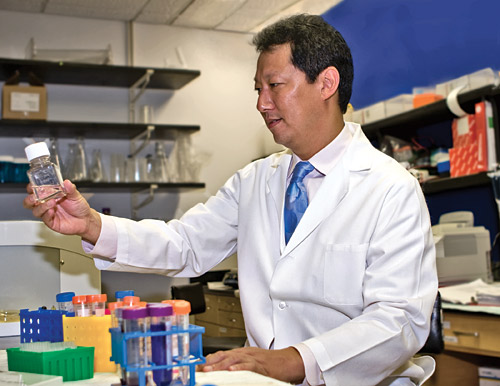Winter 2010: Dynamic Forces

Santa Ono, Senior Vice Provost for Undergraduate Education and Academic Affairs
Donna Price

hopeful: Dobbs patient Mike Riordan 95MPH and his daughter, Colleen.
Courtesy Riordan family
When the World Goes Dark
The Emory Eye Center’s Dobbs Lab seeks to prevent immune-related vision loss
By Mary J. Loftus
Santa Ono, Senior vice provost for Undergraduate Education and Academic Affairs, once stood at the side of Lac Notre Dame at the foot of the Laurentians, just north of Montreal, on a chilly autumn morning, marveling at the steam rising from the water, the multicolored leaves mirrored on the still surface, the concentric rings formed by the toss of a pebble.
As an ocular immunologist, Ono works to ensure others can continue to view such awe-inspiring sights.
His team at the R. Howard Dobbs Jr. Ocular Immunology Lab is investigating the role of the immune system in the inflammation of the eye and the progression of eye diseases.
In particular, the lab focuses on the immune component of age-related macular degeneration (AMD), ocular cancer (melanoma and retinoblastoma), and ocular inflammation.
Macular degeneration is the leading cause of sight impairment and blindness in older people. The macula, in the center of the retina, is the portion of the eye that allows for the perception of fine detail. AMD gradually destroys a person’s central vision, ultimately preventing reading, driving, and seeing objects clearly.
“If a person with AMD looks at graph paper, some of the lines will be wavy instead of straight,” Ono says. “Certain parts of the image are no longer being transferred to the brain.”
Because AMD is not painful and the brain tends to fill in “gaps” in vision, people may not notice the change in their sight until significant loss has occurred. Two forms of AMD exist—wet, which is more serious and involves abnormal blood vessel growth under the macula, and dry, in which light-sensitive cells in the macula slowly break down.
“We’ve only recently realized there is an immune component of AMD, in that the immune system is attacking the photoreceptor cells—the light-capturing cells—in the body. And the macula is the most photoreceptive rich part of the eye,” Ono says.
A person who experiences this probably has an underlying genetic predisposition for autoimmune disease.
“We are investigating the role of immunity in the pathogenesis of not only AMD, but retinal degeneration in general,” Ono says. “Various eye diseases may share an involvement of the immune system.”
Michael Riordan 95MPH, a senior financial analyst in the School of Medicine, hopes that Ono’s research produces results that can help him and others like him who are suffering vision loss that is all the more frightening because it can’t be pinned to a definitive cause.
Since he started having vision problems in March 2005, Riordan, who is otherwise in good health, has seen ophthalmologists, immunologists, neurologists, and oncologists, at Emory and at top-notch eye centers in other states, in an effort to find out what was causing his loss of vision and how it could be treated.
Riordan was finally diagnosed with autoimmune retinopathy, in part through information provided by the Dobbs Lab. Because his sister has MS and his paternal grandmother had lupus, Riordan believes his disease has a genetic component.
He had to give up driving more than three years ago. “The loss of independence is hard, when you want to go somewhere and can’t,” he says. “But I try to keep it in perspective. There are young students waiting for heart transplants.” Riordan takes the Emory shuttle to work, where he uses visual aids with his computer.
Bridget Guernsey Riordan, dean of students in Campus Life, says her husband’s disease “really took off” in early 2006. “I was paralyzed with fear,” she says. “He had a PET scan, they were checking for MS, lymphoma, all types of cancer. That was the year we spent ruling everything out.”
Riordan has been on several medications, some of which have helped to slow the progression of his disease, and he is still traveling to experts across the country for grueling examinations—many involving bright lights shined into his sensitive pupils for hours on end—in hopes that clues to an effective treatment will be revealed. He has also donated blood so his antigens and antibodies can be studied. Antigen-specific immune therapy for AMD and other eye diseases may prove viable in the future, says Ono.
The Dobbs lab, he says, already has had some success in finding biomarkers to help physicians refine their treatment strategies.
“This paves the way for the development of new diagnostics that are at the heart of predictive medicine,” says Ono.